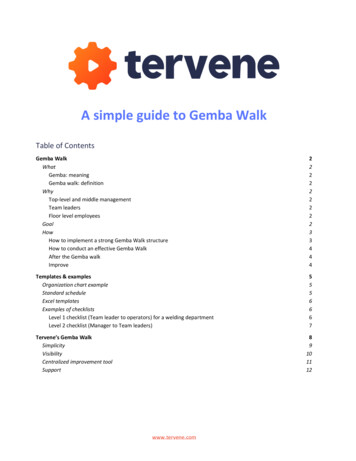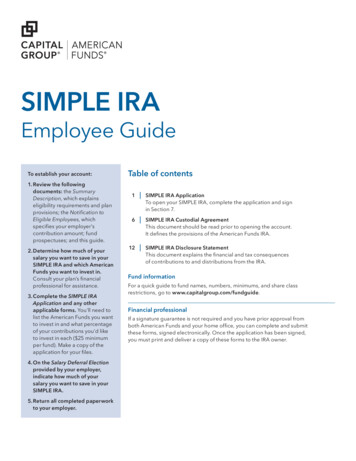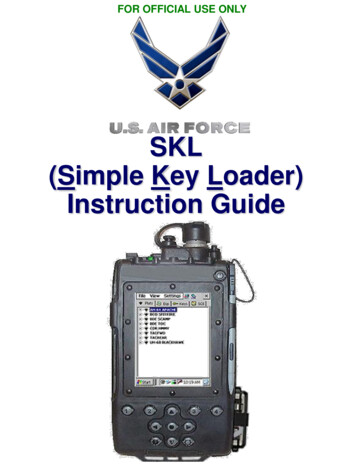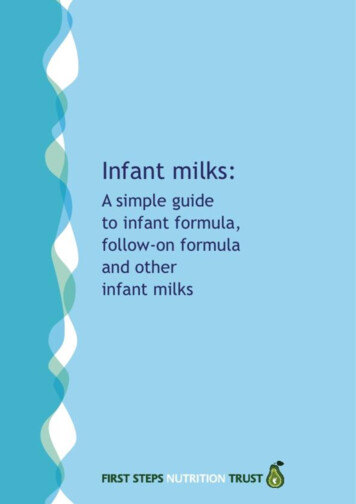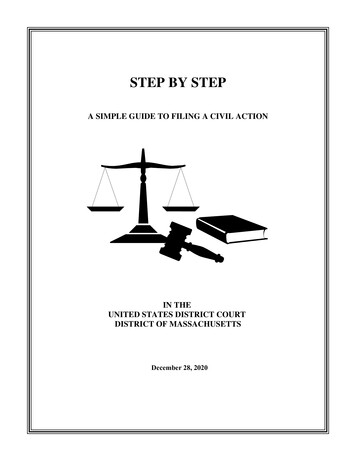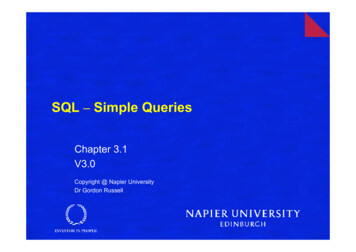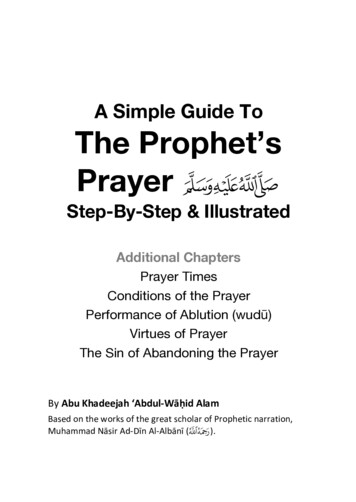
Transcription
A Simple Guide ToThe Prophet’sPrayer Step-By-Step & IllustratedAdditional ChaptersPrayer TimesConditions of the PrayerPerformance of Ablution (wudū)Virtues of PrayerThe Sin of Abandoning the PrayerBy Abu Khadeejah ‘Abdul-Wāḥid AlamBased on the works of the great scholar of Prophetic narration,Muhammad Nāsir Ad-Dīn Al-Albānī ( ).
ISBN: 9781902727585 Copyright Salafi Publications 2018All rights reserved. No part of this book may be reprinted orreproduced or utilised in any form or by any electronic, mechanicalor other means, now known or hereafter invented, includingphotocopying and recording, without prior permission from thepublishers.Second Edition: July 2018 / Dhul-Qa’dah 1439 AHSalafi Bookstore472 Coventry Road,Birmingham,United Kingdom,B10 lafiRadioabukhadeejah.comtwitter: @abukhadeejahspfacebook.com/salafipubst. 0121.773.0003t. 0121.773.0033E-Mail: info@salafibookstore.com
A Simple Guide to the Prophet’s PrayerStep-by-Step and IllustratedAll praise is due to Allāh, Lord of all creation. May Allāhextol the mention of the Prophet in the highest companyof Angels and may the peace and blessings of Allāh beupon him, his family, his Companions and all those whofollow him correctly till the Day of Judgement.The Prayer (Ṣalāh) is an act of submission andobedience before Allāh. The Muslims are expectedto pray just as the Prophet ( ) prayed, andin doing so they follow his example. Each of the fivedaily Prayers comprises a fixed number of rakʿahs (orunits) that consist of a sequence of movements andsayings. So, the dawn Prayer (Fajr) has two rakʿahs,the early afternoon Prayer (Ẓuhr) has four rakʿahs,the mid-afternoon Prayer (ʿAṣr) has four rakʿahs, thesunset Prayer (Maghrib) has three rakʿahs and thelate evening Prayer (ʿIshā) has four rakʿahs. EveryMuslim is obligated to know when to pray and howto perform the Prayer. This book aims to explain insimple terms how the Prophet ( ) prayed,step-by-step. The added chapter at the end of thisbook explains some details regarding Prayer times,conditions of the Prayer, how to perform ablution(wudū), the virtues of the Prayer and the danger ofabandoning it.1 abukhadeejah.com
Facing the Qiblah (Makkah)1. The praying personmust face the Qiblah(the direction of theKaʿbah in Makkah). Asfor the one who isunable to face theQiblah due to illness, orone who is on a ship, ina car, or on an airplane,and he fears that the time for Prayer will expire —then he prays as he is, in any direction.12. If a person is praying the optional (nafl) Prayer andhe is seated on a means of transport, it isrecommended for him, if able, to direct the means oftransport towards the Qiblah for the opening takbīr( ﻛَﺒﺮ ْ “ اﻟّﻠُﻪ ٔا Allāhu-akbar”) and then proceed on histransport as he was.23. If a person prayed towards other than the Kaʿbahmistakenly after striving to determine its direction,his Prayer is correct, and he is not to repeat it.34. Standing for the Prayer is a pillar and leaving itinvalidates the Prayer except for the one who is sickand unable to stand.4 Such a person prays seated,and if that is not possible, then he prays lying on his2 abukhadeejah.com
side.55. It is permitted for the one praying the optional(nafl) Prayers to do so while seated or standing as hewishes.66. For the one who cannot prostrate to the ground(sajdah) due to inability or sickness, then he bows(rukūʾ) and prostrates with motions of the head,making the motion of the head in sajdah lower thanthe rukūʾ.77. It is allowed to pray the obligatory Prayers on anairplane or ship, and is a must if he fears the time ofPrayer will expire. If he is likely to fall over, it isallowed for him to pray seated.88. It is permitted for a Muslim to pray barefoot justas it is allowed for him to pray in shoes or sandals.Both are from the Sunnah and it is not correct toforbid a Muslim from praying in his shoes or sandals,so long as there is no impure substance on them. Thesoil of the earth is not impure — rather it is pure.93 abukhadeejah.com
Praying with a Sutrah (a Raised Object) inFront of You and Praying Close to it9. It is obligatory that one prays towards a raisedobject (sutrah). Its height should be approximatelytwo handspans or taller, such as a saddle, or a wall,a chair, a staff or a stick embedded in the soil or apillar in a mosque. The sutrah is always kept slightlybeyond the place of prostration of the forehead.10It is Forbidden to Pray Towards a Grave10. It is not allowed to pray towards graves in anysituation, whether it be the graves of Prophets orother than them.11It is not Allowed to Pass Between a PrayingPerson and his Place of Sutrah1211. It is not allowed to pass between a prayingperson and his place of sutrah (which is normallyplaced slightly beyond his place of prostration).However, one may pass beyond the place of thepraying-person’s sutrah.12. It is allowed for a praying-person to take a stepor two forwards to prevent a child or an animal (whohave no concept of the rules of sutrah) passing infront of him so that he allows them to pass behind4 abukhadeejah.com
him.The Prayer is Invalidated if any of theFollowing Three Pass Between a PrayingPerson and his Place of Sutrah1313. The Prayer of a person is not invalidated ifsomeone passes between him and the place of hissutrah unless it is an adult woman, a donkey or ablack dog. However, it is permitted to pray with one'swife, daughter, etc. seated in front of him, or lyingdown such that he takes her as a sutrah.The Intention (Niyyah)1414. It is necessary that one has an intention (niyyah)in his heart before he begins the Prayer, such that heis aware of the Prayer he is about to perform: Hemust be aware whether he is praying Ẓuhr or ʿAṣr orMaghrib, etc. In addition, he must intend to makethe Prayer sincerely for Allāh, and not to show-off infront of those watching him.15. The intention for Prayer is not to be uttered onthe tongue because the Prophet ( ) and hisCompanions never did that. Expressing the intentionby speech is an innovation (bid’ah) and thusimpermissible.5 abukhadeejah.com
The Takbīr: “Allāhu-Akbar” Signifies the Beginningof the Prayer1516. He begins the Prayer by saying the takbīr: اﻟﱠﻠﻪُ ٔا ﻛَْﺒﺮ “Allāhu-akbar” (Allāh is Greater than all else) in awhisper and not loud, unless he is the imām wholeads others in Prayer.17. The person who is following the imām in Prayershould say the takbīr quietly in a whisperimmediately after the imām has finished saying it.Raising the Hands1618. He should raise his hands whilst saying theopening takbīr, or just before it or just after it.19. He should spread out his fingers slightly and raise6 abukhadeejah.com
his palms to the level of his shoulders or to the levelof his earlobes but without touching the ears asthere is no proof for that.The Hands on the Chest and Fixing the Sighton the Place of Prostration20. Then he should place the right hand over the lefthand, wrist and forearm upon the chest (for men andwomen). All the three methods shown in the pictureare correct.1721. Whilst standing, he should look at the placewhere he will prostrate his forehead. He should notlook around, nor look to the sky.187 abukhadeejah.com
The Recitation22. He should begin by reciting an openingsupplication of the Prayer.19 One of the more wellknown ones is:َُ وَﻻ ، ك َ وَﺗَﻌَﺎَﻟﻰ ﺟَﱡﺪ ،َ ﺳُﻤﻚ ْ كا َ وَﺗََﺒﺎَر ، ك َ ﺳْﺒﺤَﺎﻧَﻚَ اﻟّﻠﻬُﻢﱠ وَﺑِﺤَْﻤِﺪ ك َ ُ إَﻟﻪَ ﻏَﻴْﺮ “Subḥānak Allāhumma wa biḥamdika watabārakasmuka wa taʿālá jadduka wa lā ilāhaghayruka.”(I declare You free from all imperfections O Allāh, andall praise is for You. Blessed is Your Name, great andexalted is Your kingdom. And there is none worthy ofworship besides You).23. He should then recite silently in all Prayers:20ِ ﻫْﻤﺰِِه وَﻧَْﻔﺨِﻪِ وَﻧَْﻔﺜِﻪ َ ﻦ ْ ن اﻟﺮﱠﺟِﻴْﻢِ ِﻣ ِ ﻄﺎ َ ْ ﺸﻴ ﻦ اﻟ ﱠ َ ٔاﻋَﻮُْذ ﺑِﺎﻟﱠﻠﻪِ ِﻣ “Aʿūdhu billāhi min ash-shayṭān ir-rajīm minhamzihi wa nafkhihi wa nafthihi.”(I seek refuge with Allāh from Shayṭān, the rejectedoutcast, from his striking of madness, his pride andhis wicked poetry).24. Then he recites silently in every unit of the Prayer8 abukhadeejah.com
(known as a rakʿah):21 ﻦ اﻟﺮﱠﺣِﻴْﻢ ِ ﺴﻢِ اﻟﱠﻠﻪِ اﻟﺮﱠﺣَْﻤ ْ ِ ﺑ “Bismillāhi ir-Raḥmān ir-Raḥīm.”(In the Name of Allāh, the Possessor of vast mercy,the One who bestows mercy upon whomever Hewills).25. Thereafter, he recites the Opening Chapter of theQurʾān, Sūrah Al-Fātiḥah:22، ﻦ ِ َﻣﺎِﻟﻚِ ﻳَﻮِْم اﻟﱢﺪﻳ ،ِ ﻦ اﻟﺮﱠﺣِﻴﻢ ِ اﻟﺮﱠﺣَْٰﻤ ، ﻦ َ اْﻟﺤَْﻤُﺪ ِﻟﱠﻠﻪِ َربﱢ اْﻟﻌَﺎَﻟِﻤﻴ َ ﺻﺮَاط ِ ،َ ﺴﺘَِﻘﻴﻢ ْ ﻫِﺪﻧَﺎ اﻟﺼﱢﺮَاطَ اْﻟُﻤ ْ ا ، ﻦ ُ ﺴﺘَﻌِﻴ ْ َ ك ﻧ َ ك ﻧَﻌُْﺒُﺪ وَٕاﻳﱠﺎ َ ٕاﻳﱠﺎ ﻦ َ ﻦ ٔاﻧْﻌَْﻤﺖَ ﻋََﻠﻴْﻬِﻢْ ﻏَﻴْﺮِ اْﻟَﻤﻐْﻀُﻮبِ ﻋََﻠﻴْﻬِﻢْ وََﻟﺎ اﻟﻀﱠﺎﱢﻟﻴ َ اﱠﻟِﺬﻳ “Al-ḥamdulillāhi Rabbil-ʿālamīn. Ar-Raḥmān irRaḥīm. Māliki yawm id-dīn. Iyyāka naʿbudu waiyyāka nastaʿīn. Ihdinaṣ-ṣirāṭ al-mustaqīm. Ṣirāṭalladhīna anʿamta ʿalayhim, ghayr il-maghḍūbiʿalayhim, wa lāḍ-ḍāllīn.”(All praise is due to Allāh, the Lord of allexistence. The Possessor of vast mercy, the One whobestows mercy upon whomever He wills. The SoleOwner of the Day of Recompense. You alone weworship, and it is You alone we call upon foraid. Guide us to the Straight Path. The Path of those9 abukhadeejah.com
on whom you have bestowed Your bounty, not thepath of those who earned Your anger nor those whowent astray).26. For the one who cannot recite the OpeningChapter of the Qurʾān (because he is new to Islām orhas not memorised it yet), he should recite thefollowing words:23ُ وَ اﻟﱠﻠﻪُ ٔا ﻛَْﺒﺮ ،ُ وَﻻَ إَﻟﻪَ إﻻﱠ اﻟﱠﻠﻪ ،ِ وَاْﻟﺤَْﻤُﺪ ِﻟﱠﻠﻪ ،ِ ن اﻟﱠﻠﻪ َ ﺳْﺒﺤَﺎ ُِ ل وَﻻَ ُﻗﻮﱠَة إﻻﱠ ﺑِﺎﻟﱠﻠﻪ َ ْ وَﻻَ ﺣَﻮ “Subḥānallāh, wal-ḥamdulillāh, wa lā ilāha illallāh,wallāhu akbar, wa lā ḥawla wala quwwata illabillāh.”(Glorified is Allāh, free and far-removed from allimperfections. All praise is for Allāh. And none hasthe right to be worshipped except for Allāh. And Allāhis greater [than all else besides Him]. And there is nomovement nor power except by the Will of Allāh).27. And if a person has not memorised this, then heshould repeat as much as he knows of it throughoutthe Prayer.28. After the Opening Chapter (Sūrah Al-Fātiḥah) oneshould recite whatever he knows of anotherSūrah 24 of the Qur’ān. This part of the prayer is10 abukhadeejah.com
referred to as the first rakʿah (unit).29. When the imām (who leads others in Prayer)does not recite aloud, then those praying behind himshould recite Sūrah Al-Fātiḥah and other portions ofthe Qurʾān quietly to themselves (by moving theirlips). This is for the Ẓuhr and ʿAṣr Prayers. However,when the imām recites aloud, the followers merelylisten and do not recite. This is for the first tworakʿahs of Maghrib Prayer, the first two rakʿahs ofʿIshā and the two rakʿahs of Fajr.2530. In the third and fourth rakʿahs of the Prayer, heshould only recite Sūrah Al-Fātiḥah beginningwith, “Bismillāh ir-Raḥmān ir-Raḥīm.”31. It is a must that Sūrah Al-Fātiḥah is recited inevery rakʿah (unit) of every Prayer, unless prayingbehind an imām who is reciting it aloud (as in Fajr,Maghrib and ‘Ishā prayers).32. Once he has finished reciting, he remains silentfor a moment, then he raises his hands as he didwhen he began the Prayer and he utters the takbīr bysaying, ﻛَﺒﺮ ْ اﻟﱠﻠُﻪ ٔا Allāhu-akbar.2611 abukhadeejah.com
Bowing (Rukūʾ) and Prostration (Sujūd)33. Then he performs the rukūʾ (bowing) by placingthe palms of his hands on his knees, spreading hisfingers as if he is holding them firmly. He muststretch out his back keeping it straight and level, suchthat if some water was poured onto it, it would settlethere. The head should not be dipped, nor raisedhigh but instead, level with the back. He should keephis elbows away from touching his sides.2734. He recites the following in the rukūʾ:28ِ ﻈﻴْﻢ ِ َ ﻲ اْﻟﻌ َ ن َرﺑﱢ َ ﺳْﺒﺤَﺎ ُ“Subḥāna Rabbīyal-ʿadhīm.”12 abukhadeejah.com
(Glorified is my Lord, free and far-removed from allimperfections, the Supreme). He should repeat thisthree times or more.2935. It is not permitted to recite the Qurʾān in therukūʾ (bowing) or sujūd (prostration).3036. Then he raises up from rukūʾ and straightens hisback making himself upright, and as he comes upfrom the rukūʾ he recites: ﻦ ﺣَِﻤَﺪُه ْ ﺳِﻤَﻊ اﻟﱠﻠﻪُ ِﻟَﻤ َ“Samiʾ Allāhu liman ḥamidah.”(Allāh listens and responds to the one who praisesHim).Once he is upright, he raises his hands as he did whenhe first entered the Prayer to the level of hisshoulders (see point 19).3137. He stands until all of his bones return to theirplace (and puts his hands by his sides) and thenhe recites the following:32 َرﺑﱠَﻨﺎ وََﻟﻚَ اْﻟﺤَْﻤُﺪ “Rabbanā wa lakal-ḥamd.”(Our Lord! And all praise is for You).13 abukhadeejah.com
38. Then he says:33 اﻟﱠﻠﻪُ ٔا ﻛَْﺒﺮ “Allāhu-akbar.”(Allah is greater than all else).39. He then prostrates on the ground (sujūd) with hishands being placed on the ground first, before hisknees. 34 He brings his fingers together on theground, he rests on his hands and puts them forward,pointing his fingers towards the Qiblah.3540. He keeps his elbows and forearms lifted abovethe ground, and not spread out on the ground in the14 abukhadeejah.com
manner of a dog.3641. In sajdah (prostration), he firmly places hisforehead, nose, hands, knees and toes on the groundas in the illustration.42. He keeps his feet upright with the toes pointingtowards the Qiblah and his heels joined together.43. He must be settled in his sajdah and be still inthat state,37 with his forehead, nose, palms of thehands, both knees and the toes of both feet incontact with the ground.3844. In sajdah (prostration), he recites: ﻲ اﻻٔﻋَْﻠﻰ َ ن َرﺑﱢ َ ﺳْﺒﺤَﺎ ُ“Subḥāna Rabbīyal-Aʾlá.”(Glorified is my Lord, free and far-removed from allimperfections, the Most High).He should recite this three times or more. It isrecommended to be plentiful in supplicating to Allāhwhile in sajdah because it is a moment most suitedfor supplications to be answered. One should notrecite the Qurʾān in sajdah39 unless the supplicationis found in the Qurʾān.45. The rukūʾ (bowing) and sujūd (prostration) should15 abukhadeejah.com
be similar in length.4046. It is allowed to prostrate on the earth or onsomething that covers it, such as a cloth, carpet ormat.4147. Then he raises his head whilst saying: اﻟﱠﻠﻪُ ٔا ﻛَْﺒﺮ “Allāhu-akbar”,42 and he sits allowing every bone tosettle. His sitting is such that he lays his left foot flatunderneathhim and sits onit, and hekeeps his rightfoot uprightwith his toespointing in theQiblahdirection as in the picture.4348. Whilst sitting he recites:44، وَﻋَﺎِﻓِﻨﻲ ، وَاْرَﻓﻌِْﻨﻲ ، وَاﺟُْﺒﺮْﻧِﻲ ، وَاْرﺣَْﻤِﻨﻲ ، اﻟﱠﻠﻬُﻢﱠ اﻏِْﻔﺮْ ِﻟﻲ وَاْرُزْﻗِﻨﻲ “Allāhummagh-firlī, war-ḥamnī, waj-burnī, warfaʾnī wa ʿāfinī, war-zuqnī.”16 abukhadeejah.com
(O Allāh, forgive me, have mercy on me, suffice me,raise me in rank, grant me safety and wellbeing, andprovide for me).Or he can recite: َربﱢ اﻏِْﻔﺮْ ِﻟﻲ ، َربﱢ اﻏِْﻔﺮْ ِﻟﻲ “Rabbigh-firlī, Rabbigh-firlī.”(O Lord forgive me. O Lord forgive me).49. Then he says “Allāhu-akbar” and returns tomake the second sajdah (prostration) just as hemade the first one, repeating the same words (point44).4550. Then he raises his head and sits as he sat beforeuntil his bones rest in place and he remainsstationary for a moment before standing for thesecond rakʿah.4617 abukhadeejah.com
The Second Rakʿah51. To stand for the second rakʿah, he supportshimself on his two fists clenched as if he is kneadingsome dough for bread, and he returns to thestanding position as he was in the first rakʿah.4752. In the second rakʿah he recites what he recited inthe first rakʿah but without the opening supplication.So, he begins with, “Bismillāh ir-Raḥmān irRaḥīm” followed by the Sūrah Al-Fatiḥah, and thenhe recites whatever is easy for him from the Qurʾān.The second rakʿah should be made shorter than thefirst.4853. After this rakʿah, he makes rukūʾ (bows), returnsback to standing upright, and then makes the twosajdahs (prostrations) as he did previously.18 abukhadeejah.com
The First Sitting and Tashahhud (Reciting theTestification and Supplication)54. After thesecondsajdah, he sitsas he didbefore 49 andclenches hisrightfist,resting it onhis right thigh and knee, his thumb over the middlefinger, his index finger raised, pointing to the Qiblah,moving it up and down whilst keeping his vision fixedon it throughout the whole of this sitting.50 One mayalso make a circle with his middle finger and thumb(sometimes).51 He does not clench his left hand orraise its finger.5219 abukhadeejah.com
The palm of his left hand, with fingers spread out,should rest on his left thigh and knee.55. The words recited for the tashahhud in thisseated position are:53 ﻲ ﻼُم ﻋََﻠﻰ اﻟﱠﻨِﺒ ﱢ َ ﺴ َاﻟ ﱠ ،ُ ﻄـﻴﱢـَﺒﺎت وَاﻟ ﱠ ،ُ وَاﻟﺼﱠَﻠﻮَات ،ِ اﻟﺘﱠﺤِﻴﱠﺎتُ ِﻟﱠﻠﻪ ﻼُم ﻋََﻠﻴَْﻨﺎ وَﻋََﻠﻰ ﻋَِﺒﺎِد َ ﺴ َاﻟ ﱠ ،ُ ﻛﺎﺗُﻪ َ َ وََرﺣَْﻤﺔُ اﻟﱠﻠﻪِ وَﺑَﺮ ن ُﻣﺤَﱠﻤًﺪا ﺷﻬَُﺪ ٔا ﱠ ْ ؤَا ،ُ ن ﻻﱠ إَﻟﻪَ إﻻﱠ اﻟﱠﻠﻪ ْ ﺷﻬَُﺪ ٔا ْ ٔا ، ﻦ َ ْ اﻟﱠﻠﻪ اِ ﻟﺼﱠﺎِﻟﺤِﻴ ُ ﺳﻮُﻟﻪ ُ ﻋَْﺒُﺪُه وََر “At-taḥīyyātu lillāhi waṣ-ṣalawātu, waṭ-ṭayyibātu,as-salāmu ʿalan-Nabī, wa raḥmatullāhi wabarakātuhu. As-salāmu ʿalaynā wa ʿalá ʿibādillāhiṣṣāliḥīn. Ash-hadu an lā ilāha illallāh, wa ash-haduanna Muḥammadan ʿabduhu wa rasūluh.”20 abukhadeejah.com
(Words of praise, exaltation and glorification are forAllāh alone, and Prayers, worship and pure wordsand attributes also. May Allāh send peace andsecurity upon the Prophet, and His Mercy andBlessings. May Allāh send peace and security upon usand upon His righteous servants. I bear witness thatnone has the right to be worshipped except Allāh,and I bear witness that Muḥammad is His servantand Messenger).56. After that, he should supplicate with thefollowing words:54 ﺻﱠﻠﻴْﺖَ ﻋََﻠﻰ َ ﻛَﻤﺎ َ ، ل ُﻣﺤَﱠﻤٍﺪ ِ وَﻋََﻠﻰ آ ، ﻞ ﻋََﻠﻰ ُﻣﺤَﱠﻤٍﺪ ﺻ ﱢ َ اﻟﱠﻠﻬُﻢﱠ ك ﻋََﻠﻰ ْ َاﻟﱠﻠﻬُﻢﱠ ﺑَﺎِر ، إﻧﱠﻚَ ﺣَِﻤﻴٌْﺪ َﻣﺠِﻴٌْﺪ ،َ ﻫﻴْﻢ ِ ل إﺑْﺮَا ِ ﻫﻴْﻢَ وَﻋََﻠﻰ آ ِ إﺑْﺮَا ل ِ ﻫﻴْﻢَ وَﻋََﻠﻰ آ ِ ﻛﺖَ ﻋََﻠﻰ إﺑْﺮَا ْ ﻛَﻤﺎ ﺑَﺎَر َ ، ل ُﻣﺤَﱠﻤٍﺪ ِ وَﻋََﻠﻰ آ ، ُﻣﺤَﱠﻤٍﺪ إﻧﱠﻚَ ﺣَِﻤﻴٌْﺪ َﻣﺠِﻴٌْﺪ ،َ ﻫﻴْﻢ ِ إﺑْﺮَا “Allāhumma ṣalli ʿalá Muḥammad wa ʿalá āliMuḥammad, kamā ṣallayta ʿalá Ibrāhīm wa ʿalá āliIbrāhīm, innaka Ḥamīdun Majīd. Allāhumma bārikʿalá Muḥammadin wa ʿalá āli Muḥammad, kamābārakta ʿalá Ibrāhīm, wa ʿalá āli Ibrāhīm,innaka Ḥamīdun Majīd.”(O Allāh, extol and honour Muḥammad and the truefollowers of Muḥammad, just as you extolled and21 abukhadeejah.com
honoured Ibrāhīm and the pious offspring of Ibrāhīm.Indeed, you are due all praise, perfect in glory andmagnificence. O Allāh, send your blessings onMuḥammad and on the true followers ofMuḥammad, just as you sent blessings on Ibrāhīmand on the pious offspring of Ibrāhīm. Indeed, youare deserving of all praise, perfect in glory andmagnificence).The Third and Fourth Rakʿāhs57. Then he says “ اﻟﱠﻠُﻪ ٔاﻛَْﺒﺮ Allāhu-akbar”, he shouldraise his hands sometimes (to shoulder height) as hedid when beginning the Prayer55 and then stand forthe third rakʿah.58. To stand for the third rakʿah, he supports himselfon his two fists clenched as if he is kneading dough.56He returns to the standing position as he was in thefirst rakʿah.59. In the third and fourth rakʿahs he recites SūrahAl-Fātiḥah beginning with “Bismillāh ir-Raḥmān irRaḥīm”22 abukhadeejah.com
The Final Tashahhud and Sitting till the End ofthe Prayer60. After finishing the final rakʿah he performs therukūʾ, rises from it, and then prostrates (sujūd) twiceand sits to recite the tashahhud as he did afterpraying the first two rakʿahs.61. If this sitting is after the third rakʿah (as inMaghrib Prayer) or after the fourth rakʿah (as in Ẓuhr,ʿAṣr and ʿIshā prayers), then he should sit, if he is able,and without harming or restricting those next to him,as follows: with the left hip/buttock on the ground,his left foot settles under his right shin, and his rightfoot is upright next to his right hip, and his toes aredirected to the Qiblah. This is called tawarruk (seethe illustration).5723 abukhadeejah.com
62. He may also sit as he sat in the first tashahhud ifhe is praying in congregation and fears that he mayconstrict fellow worshippers.5863. He places his left hand on his left knee and issupported by that knee. He clenches his right handinto a fist as he did in the first tashahhud, he placesit on his right thigh and knee and points his indexfinger and looks at it.64. Once he has settled in this position, he reciteswhat he recited in the first tashahhud exactly. ﻲ ﻼُم ﻋََﻠﻰ اﻟﱠﻨِﺒ ﱢ َ ﺴ َاﻟ ﱠ ،ُ ﻄـﻴﱢـَﺒﺎت وَاﻟ ﱠ ،ُ وَاﻟﺼﱠَﻠﻮَات ،ِ َاﻟﺘﱠﺤِﻴﱠﺎتُ ِﻟﱠﻠﻪ ﻼُم ﻋََﻠﻴَْﻨﺎ وَﻋََﻠﻰ ﻋَِﺒﺎِد َ ﺴ َاﻟ ﱠ ،ُ ﻛﺎﺗُﻪ َ َ وََرﺣَْﻤﺔُ اﻟﱠﻠﻪِ وَﺑَﺮ ن ُﻣﺤَﱠﻤًﺪا ﺷﻬَُﺪ ٔا ﱠ ْ ؤَا ،ُ ن ﻻﱠ إَﻟﻪَ إﻻﱠ اﻟﱠﻠﻪ ْ ﺷﻬَُﺪ ٔا ْ ٔا ، ﻦ َ ْ اﻟﱠﻠﻪ اِ ﻟﺼﱠﺎِﻟﺤِﻴ ُ ﺳﻮُﻟﻪ ُ ﻋَْﺒُﺪُه وََر 24 abukhadeejah.com
“At-taḥīyyātu lillāhi waṣ-ṣalawātu, waṭ-ṭayyibātu,as-salāmu ʿalán-Nabī, wa raḥmatullāhi wabarakātuhu. As-salāmu ʿalaynā wa ʿalá ʿibādillāhiṣṣāliḥīn. Ash-hadu an lā ilāha illallāh, wa ash-haduanna Muḥammadan ʿabduhu wa rasūluh.”Followed by: ﺻﱠﻠﻴْﺖَ ﻋََﻠﻰ َ ﻛَﻤﺎ َ ، ل ُﻣﺤَﱠﻤٍﺪ ِ وَﻋََﻠﻰ آ ، ﻞ ﻋََﻠﻰ ُﻣﺤَﱠﻤٍﺪ ﺻ ﱢ َ اﻟﱠﻠﻬُﻢﱠ ك ﻋََﻠﻰ ْ َاﻟﱠﻠﻬُﻢﱠ ﺑَﺎِر ، إﻧﱠﻚَ ﺣَِﻤﻴٌْﺪ َﻣﺠِﻴٌْﺪ ،َ ﻫﻴْﻢ ِ ل إﺑْﺮَا ِ ﻫﻴْﻢَ وَﻋََﻠﻰ آ ِ إﺑْﺮَا ل ِ ﻫﻴْﻢَ وَﻋََﻠﻰ آ ِ ﻛﺖَ ﻋََﻠﻰ إﺑْﺮَا ْ ﻛَﻤﺎ ﺑَﺎَر َ ، ل ُﻣﺤَﱠﻤٍﺪ ِ وَﻋََﻠﻰ آ ، ُﻣﺤَﱠﻤٍﺪ إﻧﱠﻚَ ﺣَِﻤﻴٌْﺪ َﻣﺠِﻴٌْﺪ ،َ ﻫﻴْﻢ ِ إﺑْﺮَا “Allāhumma ṣalli ʿalá Muḥammad wa ʿalá āliMuḥammad, kamā ṣallayta ʿalá Ibrāhīm wa ʿalá āliIbrāhīm, innaka Ḥamīdun Majīd. Allāhumma bārikʿalá Muḥammadin wa ʿalá āli Muḥammad, kamābārakta ʿalá Ibrāhīm, wa ʿalá āli Ibrāhīm,innaka Ḥamīdun Majīd.”Then he adds at the end of that, the followingsupplication, seeking refuge with Allāh from fourmatters:59،ِ ﻦ ﻋََﺬابِ اْﻟَﻘْﺒﺮ ْ وَِﻣ ،َ ﻦ ﻋََﺬابِ ﺟَﻬَﱠﻨﻢ ْ اﻟﱠﻠﻬُﻢﱠ إﻧﱢﻲ ٔاﻋُﻮُْذ ﺑِﻚَ ِﻣ ل ِ ﺴﻴْﺢِ اﻟﱠﺪﺟﱠﺎ ِ ﺷﺮﱢ ِﻓﺘَْﻨﺔِ اْﻟَﻤ َ ﻦ ْ وَِﻣ ،ِ ﻦ ِﻓﺘَْﻨﺔِ اْﻟَﻤﺤْﻴَﺎ وَاْﻟَﻤَﻤﺎت ْ وَِﻣ 25 abukhadeejah.com
“Allāhumma innī aʾūdhubika min ʿadhābi jahannam,wa min ʿadhābil-qabr, wa min fitnatil-maḥyā walmamāt, wa min sharri fitnatil-Masiḥ id-Dajjāl.”(O Allāh, I seek refuge with you from the punishmentof Hellfire, and from the punishment of the Grave,from the trials of life and death, and from thetribulation of the False Messiah).65. Then he may supplicate to Allāh for whatever hepleases from the authentic supplications of the Bookand the Sunnah; and these are plentiful. However, ifhe does not know them or has not memorised them,he may still ask Allāh, uttering any supplication thatis easy for him; seeking from Allāh benefit for himselfin his religious and worldly affairs.60Salutations at the End of the Prayer (Taslīm)66. Then he turns his head to the right side and says: ﺣَﻤُﺔ اﻟﱠﻠﻪ ْ َ َاﻟﺴﱠﻼَمُ ﻋََﻠْﻴﮑُﻢْ وَر “As-salāmu ʿalaikum wa raḥmatullāh.”(May Allāh’s peace and security be upon you, and HisMercy).67. Then he turns his head to the left side and says:61 ﺣَﻤُﺔ اﻟﱠﻠﻪ ْ َ َاﻟﺴﱠﻼَمُ ﻋََﻠْﻴﮑُﻢْ وَر 26 abukhadeejah.com
“As-salāmu ʿalaikum wa raḥmatullāh.”(May Allāh’s peace and security be upon you, and HisMercy).With that, he completes his Prayer just as Allāh’sMessenger ( ) taught his followers.And all praise is due to Allāh, Lord of all creation.27 abukhadeejah.com
Purification (Wuḍū) and Prayer in Islam: itsTimes, its Pre-Conditions and VirtuesMuslims are obligated to pray to Allah five set timeseach day. This Prayer is called ṣalāh in Arabic. It is thesecond pillar of Islām. Muslims dedicate a portion oftheir time throughout the day to focus upon thisspecial act by supplicating and reciting to Allāh. Theterm ṣalāh in the Arabic language meanssupplication (duʿāʾ) and in the religious usage itrefers to the five daily Prayers that are obligatedupon every adult and sane Muslim male and female.Prayer TimesThe Prayer times are worked out from the authenticnarrations of the Prophet Muḥammad ( ).The Angel Jibrīl visited the Prophet Muḥammad( ) over two days. On the first day he led theProphet at the earliest times of the Prayers. On thesecond day, he led him at the end times of each ofthe Prayers. The five Prayer-times are based aroundthree daily events: sunrise, midday, and sunset.These times alter greatly between the seasons ofsummer and winter – and even by country. In Britain,winter Prayer times are very different to summerPrayer times. Each Prayer is announced by the adhān28 abukhadeejah.com
(the call to Prayer), which is traditionally called by amu’adhin who stands just outside the Mosque andcalls Muslims to perform the Prayer. Nowadayspeople have the adhān recorded into their phones orclocks to remind them of the Prayer times.The Prophet ( ) said: “Jibrīl led me in Prayertwice at the Kaʿbah in Makkah. So, he prayed Ẓuhrthe first day when the shadow was similar to thelength of the strap of a sandal (i.e. just aftermidday). He then prayed ʿAṣr when an object wassimilar to the length of its shadow. Then he prayedMaghrib after the sun had set and the fastingperson breaks the fast. Then he prayed ʿIshā whenthe twilight had vanished. Then he prayed Fajrwhen the true dawn began (before sunrise), andwhen eating is prohibited for the fasting person. Onthe second occasion he came, he prayed Ẓuhr whenthe shadow of an object was similar to the length ofit, which was the time of ʿAṣr starting the day before.He then prayed ʿAṣr when the shadow of an objectwas about twice as long as it. He then prayedMaghrib at the same time as he did the first time.He then prayed ʿIshā when a third of the night hadgone (just before midnight). He then prayed Fajrwhen the land glowed (before sunrise). Jibrīl thenturned towards me and said, ‘O Muhammad, these29 abukhadeejah.com
are the times of the Prophets before you, and thePrayer-time is what is between these two times.’”62So, in summary, the Prayer-times are as follows:1. Fajr: After the true dawn but before sunrise.2. Ẓuhr: Just after midday till the shadow of an objectis the same as its length.3. ʿAṣr: When the shadow of an object is the sameas its length until it is twice its length.4. Maghrib: Just after the sunset until ‘Ishā begins.5. ʿIshā: When the twilight vanishes till half the nighthas passed. Twilight is the light (or glow) thatremains in the western horizon after the sun goesdown.Conditions of the PrayerThe Prayer also has conditions — and without them,the Prayer is not valid:1. Islam. A person must be a Muslim.2. Sanity. The insane person is not obligated to pray.3. Adulthood. This is known by: coarse hair in theprivate areas, discharge of sexual fluid, reaching theage of fifteen, the onset of menstrual bleeding (infemales). Whichever of these occurs first, adulthoodis reached.30 abukhadeejah.com
4. Purification. Ablution with water (wuḍū) and ifthere is no water, then with the earth (tayammum).5. Covering the important parts of the body(ʿawrah) with loose-fitting, non-transparentgarments. The woman covers everything except herface and hands. The man must cover himself fromthe navel to the knees, and his shoulders.6. One’s body, garments and place of Prayer mustbe clean of impurities such as urine and excrement.Soil, food stains, oil, paint, etc. are not impure.7. Facing the direction of the Qiblah (Makkah)during the Prayer.8. A sincere intention of the heart — and not byutterance with the tongue. This is to know whichPrayer one is about to perform, and to make itsincerely for Allāh.9. Time: Making sure that each Prayer is prayedwithin the correct time.Wuḍū (Ablution) For The PrayerThe method of wuḍū (ablution) is explained in theQurʾān: “When you stand for Prayer, wash yourfaces, and your hands up to the elbows. Then wipeyour heads and wash your feet up to your ankles.”63In the authentic narrations, the Companionsexplained the wudū of the Prophet ( ): He31 abukhadeejah.com
washed his hands three times, then rinsed his mouthand sniffed water in his nose (in one motion) andblew it out. He then washed his face three times.Thereafter he washed his right hand up to andincluding his elbow three times, then the left onelikewise. Then he wiped his head with his wet hands,from his forehead up to (and not including) the napeof his neck and then back to his forehead. Then heput his index fingers into his ears and the thumbbehind the ear lobes. Then he washed his right footup to the ankle three times, then the left onelikewise. In one narration, ʿUthmān ( ) said, “Isaw Allah’s Messenger ( ) performingablution (wudū) like this ablution of mine.”64 Theguidance of the Prophet is that “with one handful ofwater he rinsed his mouth and cleaned his nose bysniffing water into it and then blowing it out.” 65There are also narrations that mention that eachlimb can be washed once, twice or three times.66 Toexceed upon three is not from the Sunnah.Once the feet have been washed, and socks or otherfootwear worn, a person can wipe wet hands overthe footwear for a whole day during subsequentablutions — and a traveller can do that for up tothree days so long as the footwear is not removed.Allah's Messenger ( ) said, “When one of32 abukhadeejah.com
you enters his feet into his socks whilst they arepure, then you should wipe over them: three daysfor the traveller and one day for the resident.”67The Companion, ʿAlī Ibn Abī Ṭālib ( ), said, “TheProphet ( ) made it a day and a night forthe resident, and for the traveller three days andnights, meaning: wiping over the socks.68 MughīrahIbn Shu’bah ( ) said, “The Prophet ( )made wuḍū and he wiped over his socks andsandals or shoes.”69When water is not available, then a dry purification(tayammum) is performed, which proves theobligation of purification before Prayer.It isreported that “The Prophet ( ) struck thesoil of the earth with the palms of his hands, thenblew off the dust, and wiped his face and rubbed hishands.” 70 The earth and its soil are physical andspiritual purifiers.Facing Makkah (the Ka’
The Prayer (Ṣalāh) is an act of submission and obedience before Allāh. The Muslims are expected to pray just as the Prophet ( ) prayed, and in doing so they follow his example. Each of the five daily Prayers comprises a fixed number of rakʿahs (
